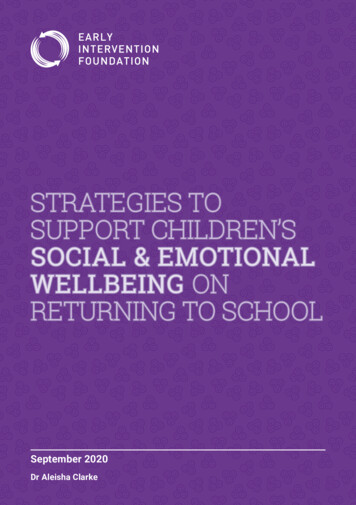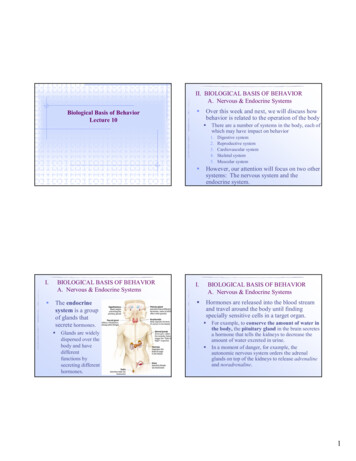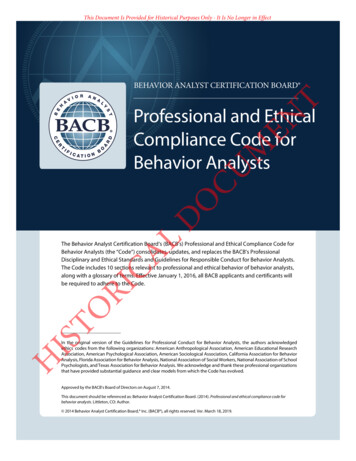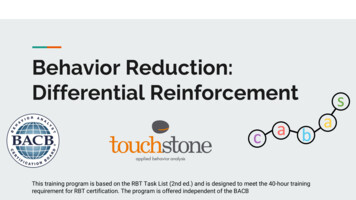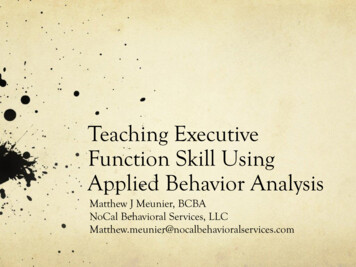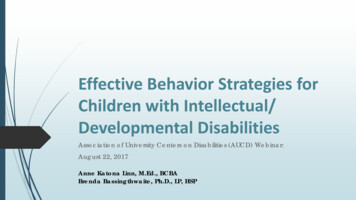
Transcription
Effective Behavior Strategies forChildren with Intellectual/Developmental DisabilitiesAssociation of University Centers on Disabilities (AUCD) Webinar:August 22, 2017Anne Katona Linn, M.Ed., BCBABrenda Bassingthwaite, Ph.D., LP, HSP
Session Description Multi-tiered systems of support (MTSS) has focusedon removing barriers to learning from an academicand behavioral perspective together in addition toproviding appropriate supports for children andyouth with Intellectual/Developmental Disabilities. This presentation will provide an overview of the keycomponents of a Multi-Tiered System of Supportframework to promote behavioral success for allchildren and youth, but with particular focus onchildren and youth with IDD.
Introduction of Presenters andGetting to Know Participants
Session ObjectivesParticipants will be able to:1.identify key components of a Multi-tiered System of Support(MTSS) to promote academic and behavioral success for ALLchildren and youth.2.identify data-based decision-making processes for useacross all tiers for selecting appropriate evidence-basedprograms.3.identify how to match rigor of assessment to severity ofconcern for students.4.identify strategies/interventions to support children and youthwith Intellectual/Developmental Disabilities across all threetiers of support.
What are some common problemswhen providing behavior support forstudents with IDD in the generaleducation classroom?Audience Input
Background and Brief History ofMulti-tiered Systems of Support
Problem Statement“We give schools strategies &systems for improving practice &outcomes, but implementationis not accurate, consistent, ordurable, & desired outcomesaren’t realized. School personnel& teams need more thanexposure, practice, & enthusiasm.”
Typical Issues in our Experiences Teacher Preparation Lack of training in behavior/classroom management for general educationteachers, lack of awareness of trauma and mental health issues, lack of training inteaching social/emotional skills, collaboration Paperwork Requirements Increased paperwork for more intensive interventions, number of students with IEPs,different data collection for different students, school district/state procedures onpaperwork. Administrative Support Building/district leadership support for positive behavior support, support forprofessional development and planning time, interpersonal support fromadministration Role Ambiguity Unclear and inconsistent expectations for teaching/behavior management, lack ofclarity for support staff, etc. Student Behavioral Difficulties varying intensity of behavior problems, dangerous and/or disruptive behaviors
Typical Issues in our Experiences Service-Delivery Issues Pull out vs. push in, full inclusion, co-teaching, teacher caseload,teacher to student ratio, different behavior strategies for eachindividual student for minor behaviors. Student Characteristics Varying age ranges of students, varying abilities of students, culturaldifferences, student learning styles, School Climate Positive or negative culture/climate, punitive vs. supportivediscipline policies/procedures, etc. Support Systems Support staff in the classroom, behavior specialist support, resourcesto implement behavior strategies and social emotional learning.
Emphasis iveReactive1980s SWDisciplineProblemLimitedeffects
Possible Solution: SWPBS Logic!Successful individual studentbehavior support is linked tohost environments or schoolclimates that are effective,efficient, relevant, durable,scalable, & logical for allstudents(Zins & Ponti, 1990)
Reinforcement Wisdom! “Knowing” or saying “know” doesNOT mean “will do” Students “do more” when “doingworks” appropriate & inappropriate! Natural consequences are varied,unpredictable, undependable, notalways preventive
SWPBS is about .Improvingclassroom &school climateIntegratingDecreasingacademic port forstudents w/EBD or IDDMaximizingacademicachievement
Prevention Logic for AllWalker et al., 1996Decreasedevelopmentof newproblembehaviorsRedesignlearning &teachingPreventTeach,worsening of environmentsmonitor, &existingto eliminate acknowledgetriggers &problempro-socialmaintainersbehaviorsbehaviorof problembehaviors
How Does SWPBIS connect to MTSS(Multi-tiered System of Support)?Alphabet Soup
A coherent continuum of evidencebased, system-wide practices tosupport a rapid response toacademic and behavioral needs withfrequent data-based monitoring forinstructional decision making toempower each student to achievehigh standards.
Tiered System Supporting Improvements inSocial Competence & Academic ingStaffBehaviorPRACTICESSupportingStudent Behavior
To provide an integrated systemicapproach to meeting the needs ofall students.To become the guiding frameworkfor school improvement activitiesto address the academic andbehavioral achievement of ALLstudents.
MTSS Includes both RtI and SW-PBSThis Photo by Unknown Author is licensed under CC BY-SA
Everychild learns and achieves to highstandards Learning includes academic and socialcompetencies Every member of the learning communitycontinues to grow, learn and reflect Every leader at all levels is responsible forevery student Change is intentional, coherent anddynamic
Key Features of Each Tier ofSupport
Supports for ALL (CORE)Academics All students Evidence-basedcore curriculum &instruction Assessment systemand data-baseddecision makingBehavior All students, AllsettingsPositive behavioralexpectationsexplicitly taughtand reinforcedConsistentapproach todisciplineAssessment systemand data-baseddecision making
Academics Supplementaltargeted skillinterventions Small groups Frequent progressmonitoring to guideintervention designBehavior Supplementaltargeted skillinterventions Small groups Frequent progressmonitoring to guideintervention design
Academics More intensesupplementaltargeted skillinterventions Customizedinterventions Frequent progressmonitoring to guideintervention designBehavior Student centeredplanning Customizedfunction-basedinterventions Frequent progressmonitoring to guideintervention design
Data-based Decision Making for AllTiers
Tiered System Supporting Improvements inSocial Competence & Academic ingStaffBehaviorPRACTICESSupportingStudent Behavior
Tier 1-Universal Decision Flow Chart
OLD SWPBIS (School Level) Data Collection ScheduleNortheastern School DistrictFallEndWinter SpringofYearScreening Data (Collected from Homeroom Teachers):SRSSXXXQualitative Data (collected from all school staff):SAS1XSSS1XQualitative Data (collected from Coach & ay/June)2Once every 3-5 years4Quantitative Data:ODR3Summarized & Analyzed MONTHLYPA School Profile & Data Summary3XXXXX
PBS Apps-Tiered Fidelity Inventory (TFI)
Fit with Existing Assessment Instruments The School-wide PBIS Tiered Fidelity Inventory (TFI) is intendedto fulfill the same functions as the: Team Implementation Checklist (TIC)Benchmarks of Quality (BoQ)Benchmarks of Advanced Tiers (BAT)PBIS Self-Assessment Inventory (SAS)Phases of Implementation (POI)Note: At this time SET, ISSET andBoQ remain the preferredresearch-quality fidelity measures The TFI addresses all three tiers, and focuses on those elementsof PBIS that are most “core” to achieving student outcomes. There is no problem continuing to use prior measures. The TFI isintended to be more efficient, but other measures may bemore comprehensive, and will remain available.
NEW SWPBIS (School Level) Data Collection ScheduleNortheastern School DistrictFallWinter SpringEndofYearScreening Data (Collected from Homeroom Teachers):SRSSXXXQualitative Data (collected from all school staff):SSS1XQualitative Data (collected from Coach & Team):TFI1SETX(Oct/Nov)2X(Jan/Feb)X(Apr/May)Once every 3-5 years4Quantitative Data:ODR3Summarized & Analyzed MONTHLYPA School Profile & Data Summary3XXXXX
Universal Data which can be used for ALL three tiers SRSS Student Risk Screening Scale (SRSS; Drummond, 1994) TFI Tiered Fidelity Inventory (All three tiers) SET School-wide Evaluation Tool (SET; Sugai, Lewis-Palmer, Todd, & Horner, 2005) SSS School Safety Survey (SSS; Sprague, Colvin, & Irvin, 2002) ODR Collected via SWIS (School-Wide Information System; Educational and Community Supports,2010) PSSA Pennsylvania School System of Assessment PVAAS Pennsylvania Value Added Assessment System Safe Schools Pennsylvania Safe Schools Online Database (https://www.safeschools.state.pa.us/) School Profile Data specifically requested from schools including: Total number of studentsStudent Attendance RateStaff Attendance RateLRE per 3 reporting categoriesReferrals for Special Education Eligibility DeterminationNewly Identified Special Education IdentificationsOSS / ISSOut-of-School Placements for StudentsOut-of-School Placements for Students with EBCollaborating MH agencyODRs – if not using SWIS; otherwise, these data provided via SWISNumber of Students with IEPsODR data analyzed for disparities by race, ethnicity, gender, etc.
Tier 2-3 Systems Response ChartypUsing this tool for action planning:This tool was designed to assist Tier 2/3 Systems Planning Teams as they strategize how to effectively intervene with students at firstindication of need, thus preventing students from being excluded from general education instruction. By discussing these data pointsregularly at team meetings, schools can identify trends and strategize to improve outcomes. For example, teams can discuss data foreach timeframe, looking for trends within each column and/or compare this year’s numbers with last year’s for similar timeframes (ex.# of students suspended in Oct. 08 with # in Oct. 09). Teams should have last year’s SRT data present when reviewing new data.Directions: 1) Determine timeframes for data collection on this tool (ex. monthly OR quarterly) 2) Designate a person responsible forgathering the data necessary to answer each question. 3) Review necessary documents/data and complete each item for designatedtimeframe. 4) Use this data/information to action plan for improvements to your secondary & tertiary support systems.Building Name:System Response OptionsA. Students being monitored bySecondary Systems Team (ex.CICO, Mentoring/CnC, FBA/BIP)B. Students being monitored byTertiary Systems Team (ex.Complex FBA/BIP, Wraparound)C. Students being considered forSpecial Education TestingD. Students with Special Educationprocess in progress (being tested,placement being considered, etc.)E. Students that were tested and didnot qualify for Special EducationF. Students suspended on oneoccasionG. Students suspended on two ormore separate occasionsH. Students placed (or at risk ofbeing placed) in separate settingor “Safe School” (ex. alternative tosuspension program)I. Students with an IEP that movedto a more restrictive settingJ. Students in Special Educationsetting, out-of-home schoolK. Students in “short-term” restrictiveplacement in clinical setting(hospitalization)L. Students with expulsion hearing inprogressM. Students expelledDate:Team Using Tool:Total # of Students in Category for Timeframe:List date/year at top of column & total # of youth in each boxDate:Date:Date:Date:Date:
Are they aligned to MTSS by ?Function-based ed & individualizedinstruction/intervention34443444 Crisis prevention & intervention232 1:1 tutoring program121 Check in/out444 Targeted social skills training332 Peer-based tutoring000 Social skills club233 Behavioral contracting444 Cognitive-behavioral counseling000 Academic small groups222 Teaching & rewarding positiveschool-wide behavioralexpectations444 Proactive school-wide discipline444 Effective academicinstruction/curriculum232 Parent engagement121 Active supervision444 Youth Mental Health First Aid343PrimarySecondaryTertiary NOTE: Use aScale from 0-4to identifylevel ofalignmentData Systems Outcomes 4
Strategies Across All Tiers andContexts
SWPBSSubsystemsClassroomFamilyNon-classroomStudent
School-wide1. Common purpose & approach to discipline2. Clear set of positive expectations & behaviors3. Procedures for teaching expected behavior4. Continuum of procedures for encouragingexpected behavior5. Continuum of procedures for discouraginginappropriate behavior6. Procedures for on-going monitoring &evaluation
Non-classroom Positive expectations & routinestaught & encouraged Active supervision by all staff– Scan, move, interact Precorrections & reminders Positive reinforcement
Examples of School-wide & Nonclassroom Strategies Reinforcement surveys for students Clear and consistent procedures for school routines and interruptions Visual Representation of School-wide Expectations throughout building/campus All school staff modeling appropriate behaviors and self-management Music playing during transitions between classes to provide calming effect (i.e. 60beats per minute) Teacher/staff awards for implementing positive behavior supports in their classrooms Special assemblies/events to reward large numbers of children/youth Trauma-informed care for ALL staff and students Voice volume scale across entire school (i.e. 0 Silence, 1 whisper voice, 2 speaking voice, 3 loud voice, 4 screaming/shouting) with examples Using multiple modes of teaching for schoolwide expectations (i.e. videos, objectlessons, integrating into academic topics, during physical education, etc.)
Classroom Classroom-wide positive expectations taught& encouraged Teaching classroom routines & cues taught &encouraged Ratio of 6-8 positive to 1 negative adultstudent interaction Active supervision Redirections for minor, infrequent behaviorerrors Frequent precorrections for chronic errors Effective academic instruction & curriculum
Examples of Universal ClassroomStrategies Cards on desk to indicate level of support needed (explicit instruction on how touse this system) Green card means “I am good working on my own” Yellow card means “I may need help, stay close by” Red card means “I need help and cannot move on” “Calm zones” in the classroom for breaks Classroom reflection sheets for rule violations The Good Behavior Game Color-coded folders for independent seatwork or group work Teaching as an “aerobic activity” Physical activity breaks throughout the day Group contingencies
Family Continuum of positive behavior support for allfamilies Frequent, regular positive contacts,communications, & acknowledgements Formal & active participation & involvement asequal partner Access to system of integrated school &community resources
Examples of Universal Family Strategies Identify ways families and communities can becomeinvolved with PBS at school Identify positive behavior support strategies to use at home Develop predictable routines at home to support positivebehavior Practice acknowledgement of positive behaviors Student, teacher, parent Positive Tickets Weekly, monthly drawings for families Announcements over PA Phone calls/post cards home to parents Write up in newsletter Community donated prizes
Tier 2 Strategies for Some StudentsSmall group interventions
More Tier 2 Strategies (Small Group) Teaching Organizational Tools Peer tutoring Structured breaks Alternatives to suspension (small group instruction in social emotionallearning, etc. Teaching conflict resolution skills Support groups for specific topics Relational aggression Grief Specialized instruction in small groups for academics Social Stories based on interest
Tier 3 Strategies (Individual Student)
MTSS Includes both RtI and SW-PBSThis Photo by Unknown Author is licensed under CC BY-SA
Not Hoop Jumping
Individual Student Behavioral competence at school & districtlevels Function-based behavior support planning Team- & data-based decision making Comprehensive person-centered planning &wraparound processes Targeted social skills & self-managementinstruction Individualized instructional & curricularaccommodations
Individualized Behavior AssessmentFunctional Behavior Assessment (FBA)
Why engage in the FBA process? The reauthorization of IDEA in 1997 provided a legalrational for FBA and BIP IDEA (2004) specifies legal requirements for childrenbeing served in special education students shall:“receive, as appropriate, a functional behavioralassessment, behavioral intervention services andmodifications, that are designed to address the behaviorviolation so that it does not recur.”Or To stop the challenging behavior from continuing
Why engage in the FBA process?
Link Between FBA and BIP FBA: Defines features of environments where the student isnot successful Leads to hypothesis about conditions needed forsuccess Behavior Intervention Plan: Defines what we will do differently to create anenvironment for success Describes what teaching is required to changebehavior
Why engage in the FBA process?
Functional Behavior Assessment
Reasons for Biting:1. Wants teacher attention2. Wants peer attention3. Does not want attention4. Does not want to work5. Wants help with the work6. Wants something to eat7. Wants to play a game8. Wants to go for a walk9. ?
Reasons for Biting:1. Wants teacher attention2. Wants peer attention3. Does not want attention4. Does not want to work5. Wants help with the work6. Wants something to eat7. Wants to play a game8. Wants to go for a walk9. ?
“I don’t have to bite my hand to avoiddoing work?”I needThink Time
Functional Behavior Assessment“I don’t have to throw my blockto get my truck back?”“I don’t have to bite my handto avoid doing work?”“I don’t have to protestto get help?”“I don’t have to pull myhair to be pushed on the swing?”“I don’t have to swear toget my peer’s attention?”“I don’t have to bite to getattention?”
“BreakPlease”Functional Behavior Assessment“I don’t have to bite my handto avoid doing work?”“I don’t have to throw my block“When theto get my truck back?”timer sounds,it is my turn”“HelpPlease”“Hi! Canwe talk?“I don’t have to protestto get help?”“I don’t have to pull myhair to be pushed on the swing?”“Push mePlease”“I don’t have to swear toget my peer’s attention?”“I don’t have to bite to getattention?”“Watchme”
Why engage in the FBA process? Does NOTwork to gainor escapeProblemBehaviorAppropriateBehavior Does workto gain orescapeChange in what we reinforce!
Functional Behavior AssessmentDefined
A Functional Behavior Assessment A Functional Behavior Assessment (FBA) “is a set ofassessment procedures that results in the identificationand description of the relationships between uniquecharacteristics of the individual and the contextualvariables that trigger, motivate, and reinforce behavior.The FBA is used as the basis for designing individuallytailored interventions.” (Steege & Watson, 2009, p. 7)
A Functional Behavior Assessment A Functional Behavior Assessment (FBA) “is a set ofassessment procedures that results in the identificationand description of the relationships between uniquecharacteristics of the individual and the contextualvariables that trigger, motivate, and reinforce behavior.The FBA is used as the basis for designing individuallytailored interventions.” (Steege & Watson, 2009, p. 7)
A Functional Behavior Assessment “a set of assessmentprocedures”We become behavioraldetectives trying tounderstand a student’sbehavior.
A Functional Behavior Assessment Identification and description of the relationshipsbetween unique characteristics of the individual and thecontextual variables that trigger, motivate, and reinforcebehavior.Contextual Variables AntecedentsIndividual BehaviorReinforce Consequence
Examples of Individual Characteristics Medical Development Typically developing? Developmental Disability diagnosis? Communication methods Words, gestures, none, other (PECs, Assistive Technology) Academic level Grade level Mental Health: Anxiety, ADHD, Depression Traumatic experiences What is happening in the student’s environment outside of school thatmay be impacting in-school behavior?Important for understanding how the individualinteracts with his or her environment
What are the Antecedents?
What are the Antecedents?Type of workMaking corrections?DifficultylevelLevel ofTeacher AttentionPreference?Turn taking?Stopping Preferred?Work withPeers?Who has Teacherattention?WorkAlone?
Functional Behavior Assessment Identification and description of the relationshipsbetween unique characteristics of the individual and thecontextual variables that trigger, motivate, and reinforcebehavior Reinforcement Look at the ConsequencesWhat happened after the behavior?What did the teacher do?What did other students do?
Functions of BehaviorPositive ReinforcementNegative Reinforcement GAIN ESCAPE access to a socialinteraction(ATTENTION) access to an itemor an activity(TANGIBLE) a social interaction an item, activity, ortask(ESCAPE or AVOID)
Functions of BehaviorDid the student gainsomething?Did the student avoidsomething? Teacher redirect? Teacheroffer help? Crisis teamresponded? Principal showup? Go to the office so work wentaway? Peer laughed? Peerredirected? Peer leave them alone? Did the student get an itemback? Did the student get otherpreferred things? (sensory toys) Redirected to a differentactivity? Teacher leave them alone?
What Functions of Behavior
Functions of BehaviorSocial FunctionsNon-Social FunctionAUTOMATIC
Functional BehaviorAssessmentWhich assessment is functional?
A Functional Behavior Assessment Type of assessments we use Review of records Interviews Observations in the classroom Choice Assessments/Choice Analysis Assess by the choices the student makes Antecedent Analysis Assess the effect of changing “front-end” strategies Functional Analysis Assess the effect of “giving in” to the behavior within acontext
Matching Intensity of Behavior withIntensity of AssessmentIntensity ofBehaviorsIntensity ofAssessmentSelf-InjuryInterview
Matching Intensity of Behavior withIntensity of AssessmentIntensity ofBehaviorsIntensity ofAssessmentSelf-InjuryInterview
Matching Intensity of Behavior withIntensity of AssessmentBehavior Considerations Disruption to learning ofthe individual or others Possibility of injury to theindividual or others Consideration for safetyAssessmentConsiderations Type of data being collected Record review/office referrals Interview Observations Systematic assessment thatshows cause/effect The amount of data (multipledays, multiple sources) Level of analysis
Intensity of Behavior based on TopographyLowMedium Verbal: arguing, name calling, blurting out, Physical movements: head down on desk,turning away, pouting Stereotypy that doesn’t interfere with learning Out of seat but staying in work areaHighIntense
Intensity of BehaviorLow Verbal: arguing, namecalling, blurting out, Physical movements: headdown on desk, turningaway, pouting Stereotypy that doesn’tinterfere with learning Out of seat but staying inwork areaMediumHigh Verbal Disruption: swearing, yelling,crying Physical: pushing paper away,throwing an item Elopement from work area (stay inroom) Stereotypy that interferes withlearningIntense
Intensity of BehaviorLow Verbal: arguing, namecalling, blurting out, Physical movements: headdown on desk, turningaway, pouting Stereotypy that doesn’tinterfere with learning Out of seat but staying inwork areaMedium Verbal Disruption:swearing, yelling, crying Physical: pushingpaper away, throwingan item Elopement from workarea (stay in room) Stereotypy thatinterferes with learningHighIntense Aggression that does not cause injury to selfor others (push, hits with open hand) Self-Injury that lacks force for skin damage Property Destruction with items (e.g., pencil,paper) Elopement from classroom
Intensity of BehaviorLow Verbal: arguing, namecalling, blurting out, Physical movements:head down on desk,turning away, pouting Stereotypy that doesn’tinterfere with learning Out of seat but stayingin work areaMedium Verbal Disruption:swearing, yelling, crying Physical: pushingpaper away, throwingan item Elopement from workarea (stay in room) Stereotypy thatinterferes with learningHigh Aggression that does notcause injury to self orothers (push, hits withopen hand) Self-Injury that lacks forcefor skin damage Property Destruction withitems (e.g., pencil, paper) Elopement fromclassroomIntense Aggression that can cause injury Self-injurious behaviors thatcause bruising, callouses, brokenskin, leaving teeth marks Property Destruction: throwingfurniture, potential for damagesto property Eloping from the building
Factors to Consider forDefining Intensity of Assessment
Rigor of AssessmentLowMedium Case review, collected Progress monitoring data reviewed Indirect (interview/rating scale) with 2 ormore sources Observations that are summarizedHighIntense
Rigor of AssessmentLow Case review Progress monitoringdata reviewed Indirect(interview/rating scale)with 2 or more sources Observations that aresummarized but notanalyzed for A/CMediumHighIntense Some analysis of pre-existing data for A,B,C (case review,progress monitoring) Analyze ABC data, Scatterplot data across 1-3 dayscollected by another adult. Conduct 2-3 observations with outcome of convergenceof data.
Rigor of AssessmentLow Case review, collected Progress monitoringdata reviewed Indirect(interview/rating scale)with 2 or more sources Observations that aresummarized but notanalyzed for A/CMedium Some analysis of pre-existingdata for A,B,C (case review,progress monitoring) Analyze ABC data,Scatterplot data across 1-3days collected by anotheradult. Conduct 2-3 observationswith outcome ofconvergence of data.HighIntense Analyze at least 5 days of ABC data orScatterplot data. Over 3 ABC observations are analyzed, supportother data collected Antecedent Analysis Conduct “probes” of experimentalassessment/choice analyses just to have moreconvergent data. Probes mean no design or notnecessarily testing several variables.
Rigor of AssessmentLow Case review, collected Progress monitoringdata reviewed Indirect(interview/rating scale)with 2 or more sources Observations that aresummarized but notanalyzed for A/CMedium Some analysis of pre-existingdata for A,B,C (case review,progress monitoring) Analyze ABC data,Scatterplot data across 1-3days collected by anotheradult. Conduct 2-3 observationswith outcome of convergenceof data.High Analyze at least 5 days of ABCdata or Scatterplot data. Over 3 ABC observations areanalyzed, support other datacollected Antecedent Analysis Conduct “probes” ofexperimentalassessment/choice analysesjust to have more convergentdata. Probes mean no designor not necessarily testingseveral variables.Intense Conducted a choice analysis withreversals/repetitions or Conducted a functional analysis,that is graphed and differentiated Multiple functions tested. Analyzed intervention data tosupport function/intervention.
Continuum of Assessments in FBAsFunctional BehavioralAssessmentsIndirect MethodsBehavioralChecklistsBehavioralInterviewsLow PowerNaturalisticAssessmentsABC edentAnalysisFunctionalAnalysisHigh Power
Intensity of Intervention Changes in Setting (LRE) Level of reinforcement How often? How long? Changes BIP makes to Expectations for Behavior orAcademics How much work do they get to avoid? Use of Punishment Time-out, restraint, losing access to peers or preferredclasses
Continuous Problem SolvingCollectDataAnalyzeAdjust
Continuum of Assessments in FBAsFunctional BehavioralAssessmentsIndirect MethodsBehavioralChecklistsBehavioralInterviewsLow PowerNaturalisticAssessmentsABC edentAnalysisFunctionalAnalysisHigh Power
CollectDataAnalyzeHow are my “Reinforcers” working?(consequences for appropriate behaviors)Adjust Preference assessments to change activities: Tired of working for peanuts? Tired of working for adult attention? Tired of working for a game? Changing what students work for or behave for can make all thedifference
CollectDataAnalyzeHave the Antecedents Changed?Adjust Activity Format Can student do it? Independent Do they understand it? Small Group Is it preferred? Large Group Attention Type of directions Who gives it? Stop something When do is it given? Do something What does it look like?
CollectDataAnalyzeAdjustHas Student Changed? Medical Development Typically developing? Developmental Disability diagnosis? Communication methods Words, gestures, none, other (PECs, Assistive Technology) Academic level Grade level Mental Health: Anxiety, ADHD, Depression Traumatic experiencesImportant for understanding how the individualinteracts with his or her environment
Session ObjectivesParticipants will be able to:1.identify key components of a Multi-tiered System of Support(MTSS) to promote academic and behavioral success for ALLchildren and youth.2.identify data-based decision-making processes for useacross all tiers for selecting appropriate evidence-basedprograms.3.identify how to match rigor of assessment to severity ofconcern for students.4.identify strategies/interventions to support children and youthwith Intellectual/Developmental Disabilities across all threetiers of support.
Contact InformationBrenda Bassingthwaite, PhD, LP, HSP,Manager of Behavioral OutreachServicesUniversity of Iowa Stead FamilyChildren
to implement behavior strategies and social emotional learning. 1980s SW Discipline Problem. Reactive. Non-constructive. Emphasis on punishment. Poor implementation fidelity. Limited . System Response Options Total # of Students in Category for Timeframe: List date/year at top of column & total # of youth in each box ; Date: Date: Date: Date .







